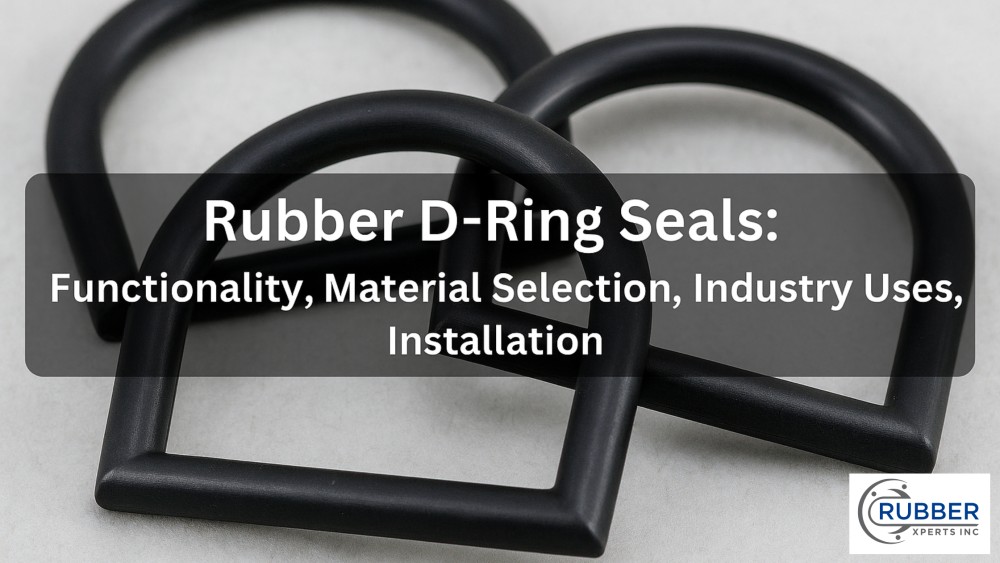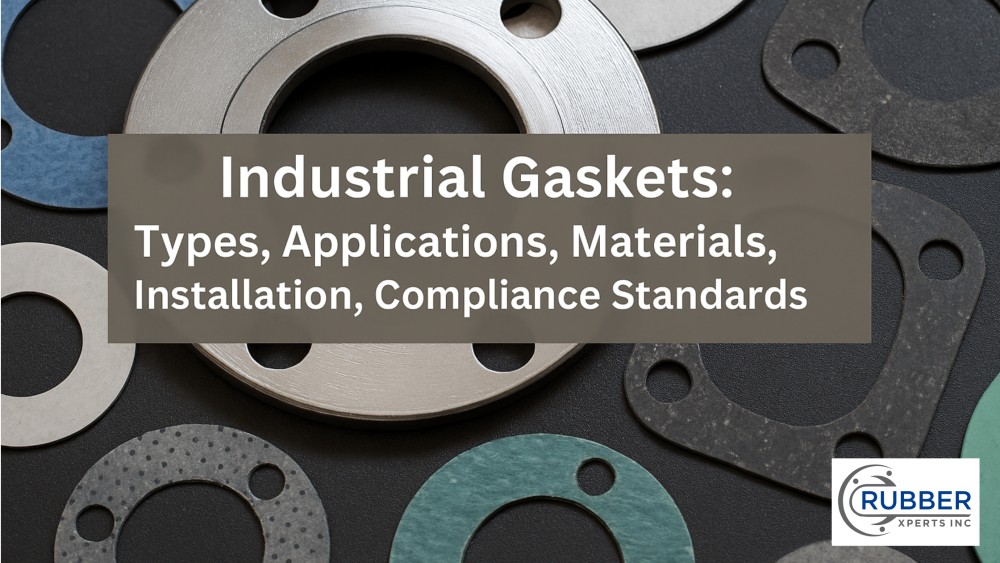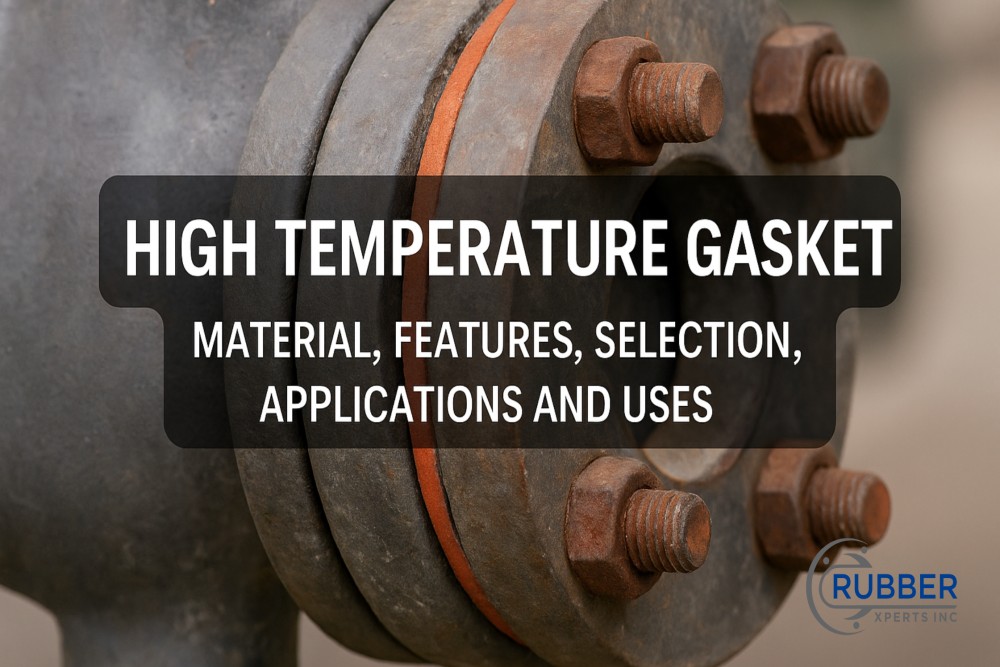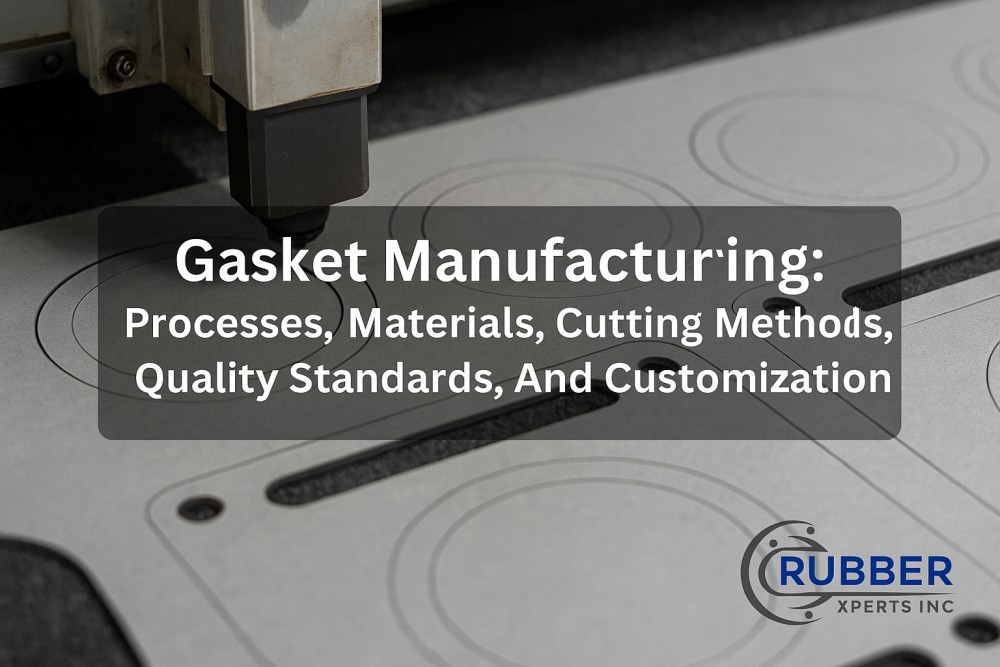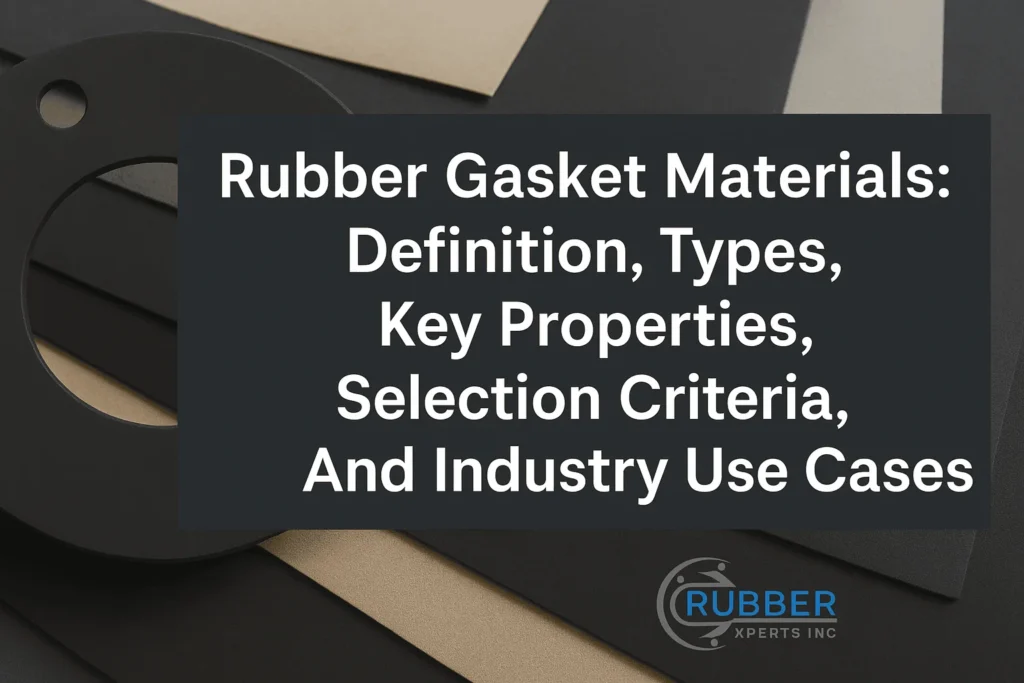Rubber compounds are specialized elastomeric materials formed through the compounding process, where natural or synthetic rubber is blended with additives to enhance performance. Their formulation is customized for various industrial applications, making them indispensable in modern manufacturing.
The composition of rubber compounds includes fundamental ingredients such as base polymers, curing agents, fillers, and stabilizers. These additives modify properties like tensile strength, thermal resistance, and chemical resistance. Manufacturers optimize rubber compounds for specific applications by carefully adjusting the formulation, ensuring superior mechanical performance and longevity.
There are multiple types of rubber compounds, including natural rubber, synthetic rubber, and specialty elastomers like EPDM, neoprene, and silicone. Each type offers distinct advantages, such as oil resistance, weatherability, or high-temperature stability. The selection depends on the intended application, ensuring the material meets industrial and environmental demands.
The key properties of rubber compounds are hardness, tensile strength, elasticity, and abrasion resistance. These attributes define their suitability for diverse uses, from flexible seals to high-strength industrial components. Rubber processing ensures longevity and optimal performance in demanding conditions by enhancing properties like chemical resistance and thermal stability.
The applications of rubber compounds span across industries, including automotive, marine, healthcare, and packaging. Used in tires, conveyor belts, gaskets, and medical devices, these materials contribute to safety, efficiency, and reliability. Their ability to withstand extreme temperatures, chemicals, and mechanical stress makes them important for industrial applications.
Manufacturing techniques such as mixing, calendering, extrusion, molding, and vulcanization shape the final properties of rubber compounds. These processes determine material consistency, strength, and flexibility, ensuring the production of high-quality rubber products. The rubber industry continuously innovates to enhance processing efficiency and sustainability, meeting global market demands.
What is a Rubber Compound?
Rubber Compounds are a carefully engineered mixture of elastomeric materials, additives, and curing agents designed to achieve specific performance characteristics. These compounds are formulated by blending natural and synthetic polymers with various reinforcing fillers, stabilizers, and processing aids to enhance properties such as flexibility, hardness, elasticity, and tensile strength.
The molecular structure of the rubber formulation determines its durability, resistance, and application suitability. Through the compounding process, industrial elastomers are optimized for diverse applications by adjusting their chemical properties.
What is the Definition of Rubber Compounding?
Rubber compounding is the process of mixing raw elastomeric materials with additives, reinforcements, curing agents, and stabilizers to achieve desired chemical and mechanical properties. This process customizes the rubber’s flexibility, hardness, tensile strength, and durability for specific industrial applications.
What is the Composition of Rubber Compounds?
The composition of rubber compounds consists of a combination of elastomeric materials, additives, and curing agents that determine the material’s physical and chemical properties. This composition defines the final rubber product’s flexibility, hardness, durability, and performance. It involves selecting and blending various components, including the base polymer, curing system, fillers, and stabilizers, to meet specific industrial requirements.

The composition of rubber compounds is as follows:
Rubber Polymer
Rubber polymer, also known as the base polymer, is the primary elastomeric component that provides the fundamental characteristics of elasticity, flexibility, and mechanical strength. It is either natural rubber (NR) or synthetic rubber, such as Styrene-Butadiene Rubber (SBR), Nitrile Rubber (NBR), or Ethylene Propylene Diene Monomer (EPDM).
The polymer modification process allows for improved compatibility with other ingredients, optimizing the overall performance of the compound. The purpose of the rubber polymer is to serve as the foundation of the rubber compound, providing resilience and elasticity.
Rubber polymer is blended with various additives to enhance specific properties such as heat resistance, wear resistance, and chemical stability during processing. They are important in determining the final characteristics of the compound and influencing its flexibility, aging resistance, and mechanical behavior in different environments.
Vulcanizing Agents
Vulcanizing agents, primarily sulfur and accelerators, are necessary for the curing system of rubber compounds. Vulcanization is the chemical process that cross-links polymer chains, enhancing the rubber’s strength, elasticity, and resistance to wear. Accelerators, such as thiazoles and sulfenamides, speed up the vulcanization process, while stabilizers help maintain long-term durability.
The purpose of vulcanizing agents is to improve the mechanical properties of rubber, making it more durable and suitable for demanding applications. The vulcanization process ensures that the rubber maintains its shape and performance under stress, heat, and environmental exposure.
The process of vulcanization is fundamental in converting raw rubber into a usable material with improved elasticity, resilience, and thermal stability, making it suitable for industrial and commercial applications.
Fillers
Fillers are materials added to rubber compounds to enhance mechanical properties, processing characteristics, and cost-effectiveness. Reinforcing agents such as carbon black and silica fillers improve tensile strength, abrasion resistance, and overall durability, making the rubber more resistant to wear and tear. Non-reinforcing fillers, such as clay and calcium carbonate, act as plasticizers and softeners, improving processability and reducing production costs.
Fillers modify the hardness, flexibility, and performance characteristics of rubber compounds. Carbon black, a commonly used reinforcing agent, significantly enhances tensile strength and UV resistance, while silica fillers provide superior wet traction and heat resistance.
The careful selection of fillers allows manufacturers to customize the compound’s properties to meet specific application needs, balancing strength, flexibility, and economic feasibility.
Antioxidants and Antiozonants
Antioxidants and antiozonants are important anti-aging agents that protect rubber compounds from degradation caused by oxygen, ozone, heat, and UV exposure. These stabilizers prevent premature cracking, brittleness, and loss of elasticity, ensuring that rubber products maintain their performance over time. Flame retardants are also added in specific applications to enhance fire resistance and safety.
The primary purpose of antioxidants and antiozonants is to extend the service life of rubber products by slowing down the oxidation and ozone attack processes that lead to material breakdown.
These protective additives are required in applications exposed to harsh environmental conditions, such as automotive tires, industrial seals, and outdoor rubber components. By incorporating these stabilizers, rubber compounds gain improved durability, reduced maintenance requirements, and enhanced reliability in long-term applications.
What Are Antioxidants and Antiozonants?
Antioxidants and Antiozonants are chemical additives used in rubber compounds to prevent degradation caused by oxygen, ozone, heat, and UV exposure. These stabilizers protect the rubber from oxidative aging and surface cracking, ensuring long-term durability and performance. Antioxidants slow down the oxidation process by neutralizing free radicals that cause molecular breakdown, while antiozonants specifically shield rubber surfaces from ozone attack, preventing the formation of cracks and brittleness.
In rubber applications, oxidation occurs when oxygen interacts with the polymer chains, leading to a gradual loss of elasticity and mechanical strength. This degradation is accelerated by heat and environmental exposure, making antioxidants important in preserving the material’s integrity.
Conversely, antiozonants are necessary for rubber products exposed to outdoor conditions, where ozone causes surface cracking, commonly seen in tires, seals, and industrial elastomers. These additives function by forming a protective barrier or reacting with ozone before it damage the rubber.
The effectiveness of antioxidants and antiozonants depends on the type and concentration used in the rubber formulation. Common antioxidants include amines and phenolic compounds, which enhance heat resistance and prolong rubber lifespan.
Antiozonants include wax-based or chemical protectants that migrate to the rubber surface, providing a continuous shield against ozone exposure. Their combined use significantly improves rubber’s resistance to environmental stress, extending the service life of products in automotive, aerospace, and industrial applications.
Accelerators
Accelerators are chemical compounds added to rubber formulations to speed up the vulcanization process, ensuring efficient cross-linking of polymer chains. They work alongside sulfur and other curing agents to enhance the reaction rate, reducing curing time while improving the mechanical properties of the final rubber product.
Accelerators such as thiazoles, sulfenamides, and dithiocarbamates are widely used, each offering different curing speeds and properties. The purpose of accelerators is to optimize the curing process by making it more efficient, reducing production costs, and improving the elasticity, tensile strength, and heat resistance of rubber compounds.
The presence of accelerators ensures that the rubber cures evenly and consistently, preventing defects and enhancing overall performance in demanding applications. By selecting the right accelerator system, manufacturers control processing speed, improve aging resistance, and fine-tune the balance between flexibility and hardness in rubber products.
Cure Agents
Cure agents, also known as vulcanizing agents, are major components in rubber compounding that enable the cross-linking of polymer chains to transform raw elastomers into durable, elastic materials. Sulfur is the most widely used cure agent, though alternative systems such as peroxides and metal oxides are also utilized depending on the application.
The purpose of cure agents is to create a stable three-dimensional network within the rubber structure, improving properties such as strength, flexibility, and thermal stability. The curing process, also known as vulcanization, enhances the rubber’s resistance to mechanical stress, heat, and environmental factors, ensuring long-term reliability. Cure agents define the final performance characteristics of the rubber, with the choice of curing system directly influencing factors such as elasticity, hardness, and resistance to aging and degradation.
What are the Different Types of Rubber Compounds?
The different types of rubber compounds are Natural Rubber Compounds, Styrene Butadiene Rubber (SBR) Compounds, EPDM Rubber Compounds, Chloroprene (Neoprene) Rubber Compounds, Chlorinated Polyethylene Rubber Compounds, Butyl Rubber Compounds, Silicone Rubber Compounds, and Fluoroelastomer Rubber Compounds. Each type has unique properties, manufacturing processes, and applications, catering to specific industrial needs such as oil resistance, heat resistance, and chemical resistance.
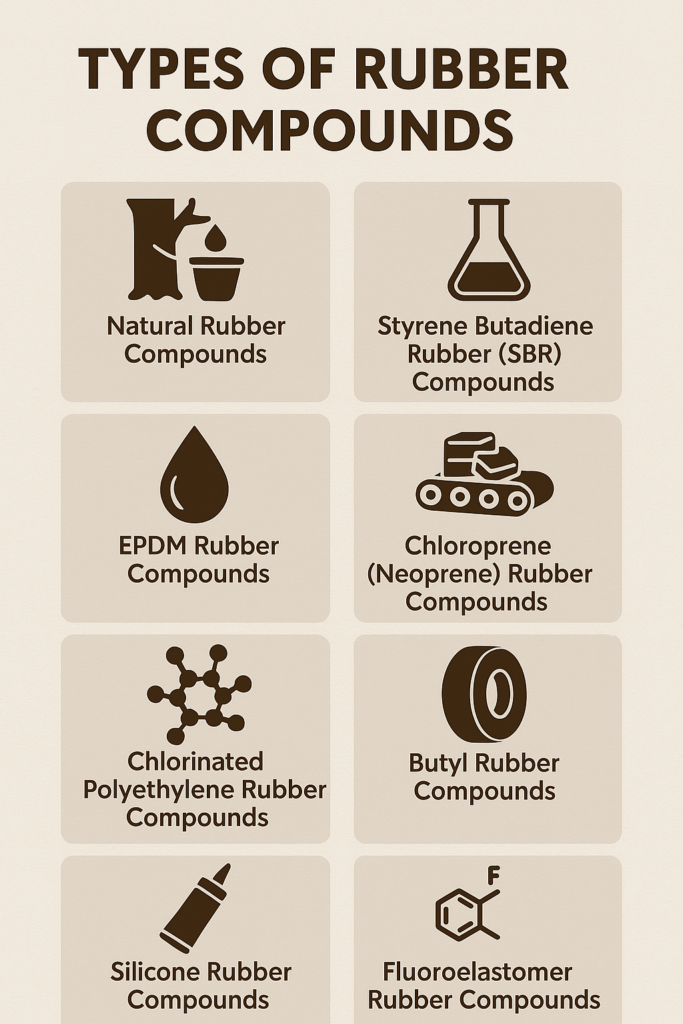
Natural Rubber Compounds
Natural rubber compounds are derived from latex, a milky fluid obtained from rubber trees. These compounds are known for their excellent elasticity, tensile strength, and abrasion resistance.
Natural rubber undergoes a vulcanization process where sulfur and accelerators are added to enhance durability and flexibility. It is widely used in applications such as tires, conveyor belts, and industrial gaskets due to its superior mechanical properties and resistance to wear and tear.
Styrene Butadiene Rubber (SBR) Compounds
SBR compounds are a type of synthetic rubber formulated by polymerizing styrene and butadiene. They are designed to provide improved abrasion resistance, aging stability, and lower production costs compared to natural rubber.
The compounding process includes reinforcing agents like carbon black to enhance durability. SBR is commonly used in tires, footwear, and automotive parts due to its balance of strength, flexibility, and cost-effectiveness.
EPDM Rubber Compounds
EPDM rubber compounds are made from Ethylene Propylene Diene Monomer, a type of synthetic rubber known for its excellent weather, ozone, and heat resistance. These compounds are produced by polymerizing ethylene and propylene with a small amount of diene to introduce cross-linking capabilities.
EPDM is used in roofing membranes, automotive seals, and industrial hoses due to its exceptional resistance to outdoor conditions and long service life.
Chloroprene (Neoprene) Rubber Compounds
Chloroprene rubber, commonly known as neoprene, is a synthetic rubber compound valued for its oil-resistant and chemical-resistant properties. It is manufactured by polymerizing chloroprene monomers, producing high-performance rubber with good mechanical strength and thermal stability.
Neoprene is widely used in wetsuits, industrial gaskets, and protective coatings where resistance to oils, solvents, and weathering is required.
Chlorinated Polyethylene Rubber Compounds
Chlorinated Polyethylene (CPE) rubber compounds are produced by chemically modifying polyethylene with chlorine to enhance flexibility, heat resistance, and chemical resistance. These compounds offer excellent flame retardancy and resistance to oils, UV exposure, and harsh chemicals.
Chlorinated Polyethylene (CPE) rubber compound is commonly used in automotive hoses, wire and cable insulation, and industrial seals due to its durability and versatility.
Butyl Rubber Compounds
Butyl rubber compounds are formulated from isobutylene and a small amount of isoprene, creating a highly impermeable synthetic rubber. They are known for their excellent air retention, chemical resistance, and vibration-damping properties.
Butyl rubber is produced through polymerization and is widely used in tire inner tubes, pharmaceutical stoppers, and high-performance rubber applications where airtight sealing and chemical resistance are required.
Silicone Rubber Compounds
Silicone rubber compounds are high-performance rubber materials made from silicone polymers, known for their outstanding heat resistance, flexibility, and biocompatibility. They are manufactured through a cross-linking process involving curing agents such as peroxides or platinum catalysts.
Silicone rubber is extensively used in medical devices, cookware, automotive gaskets, and aerospace applications due to its ability to withstand extreme temperatures and environmental conditions.
Fluoroelastomer Rubber Compounds
Fluoroelastomer rubber compounds, called FKM or Viton®, are specialty rubbers designed for high-performance applications requiring exceptional chemical resistance and heat stability.
These compounds are synthesized from fluorinated monomers, making them highly resistant to oils, fuels, and aggressive chemicals. Fluoroelastomers are widely used in aerospace, automotive fuel systems, and industrial sealing applications where durability and extreme environmental resistance are necessary.
What Are the Properties of Rubber Compounds?
The properties of rubber compounds are hardness, resistance, tensile strength, abrasion, and flexibility. These properties define the material’s behavior under different conditions and determine its suitability for various applications. In rubber science, properties refer to the mechanical, chemical, and thermal characteristics that influence performance. Rubber compounds are designed to exhibit a balance of elasticity, tensile strength, wear resistance, and durability, making them suitable for industrial, automotive, and consumer applications.

The properties of rubber compounds are as follows:
Hardness
Hardness measures a rubber compound’s resistance to deformation under pressure. It determines how firm or soft the material feels and is measured using the Shore A or Shore D hardness scale.
The rubber hardness affects its compression set, elasticity, and durability in load-bearing applications. A higher hardness level enhances wear resistance and load-bearing capacity, making the rubber ideal for seals, gaskets, and industrial rollers.
On the other hand, softer rubber compounds offer better flexibility and rebound resilience, making them suitable for cushioning and vibration-damping applications.
Resistance
Resistance in rubber compounds refers to their ability to withstand external factors such as heat, chemicals, weather, and mechanical stress. Heat resistance ensures rubber does not degrade under high temperatures, while chemical resistance protects against oils, fuels, and solvents.
Weatherability is necessary for outdoor applications, ensuring rubber maintains its properties despite prolonged exposure to UV radiation, ozone, and moisture. High resistance levels make rubber compounds ideal for harsh environments, such as automotive components, industrial hoses, and sealing systems.
Tensile Strength
Tensile strength is the maximum amount of stress a rubber compound can withstand while being stretched before breaking. It is measured in megapascals (MPa) and is important in determining the material’s durability and elongation properties.
Rubber compounds with high tensile strength exhibit superior elasticity and flexibility, allowing them to endure repeated stretching and mechanical stress without failure.
The properties of tensile strength are important for applications such as conveyor belts, automotive tires, and industrial seals, where strong and durable rubber is required.
Abrasion
Abrasion resistance refers to a rubber compound’s ability to withstand wear and friction caused by continuous contact with rough surfaces. This property is required in applications exposed to high levels of mechanical stress, such as tires, conveyor belts, and industrial flooring.
Rubber compounds with excellent abrasion resistance are formulated with reinforcing agents like carbon black or silica to enhance durability. High-abrasion-resistant rubber ensures a longer service life, reducing maintenance costs and improving reliability in demanding environments.
Flexibility
Flexibility is the ability of a rubber compound to bend, stretch, and return to its original shape without cracking or breaking. It is a key property that defines the material’s elasticity, elongation, and rebound resilience.
Flexible rubber compounds exhibit superior compression set resistance, allowing them to maintain their form even under constant pressure or deformation.
Flexibility makes them ideal for applications such as shock absorbers, gaskets, and medical tubing, where maintaining elasticity and shape retention is necessary.
What Are the Applications of Rubber Compounds?
The applications of rubber compounds are found across various industries, including automotive, marine, healthcare, oil & gas, and packaging. These industries rely on rubber compounds for their durability, flexibility, and resistance to harsh conditions. Rubber is important in manufacturing automotive parts, seals and gaskets, industrial hoses, conveyor belts, medical devices, and adhesives, and ensures performance, safety, and longevity in various applications.

The applications of rubber compounds are as follows:
Automotive Applications
The automotive industry extensively uses rubber compounds to produce necessary components that ensure vehicle performance, safety, and comfort. Tires, made from a blend of natural and synthetic rubber, provide durability, traction, and wear resistance.
Seals and gaskets made from high-performance rubber prevent fluid leaks in engines and braking systems, while vibration-dampening materials reduce noise and improve ride comfort.
Industrial hoses made of rubber are used for fuel transfer, coolant circulation, and air intake systems, ensuring the efficient functioning of automotive engines and mechanical systems.
Marine Applications
The marine industry relies on rubber compounds for components that withstand extreme environmental conditions, including saltwater exposure, UV radiation, and temperature fluctuations.
Rubber is used in marine seals and gaskets to ensure watertight protection in ship hulls and engine compartments. Rubber fenders and vibration-dampening pads provide impact resistance for docks and vessels, preventing damage from collisions.
Industrial hoses made from rubber are used in marine fuel transfer systems and hydraulic applications, ensuring safety and efficiency in maritime operations.
Healthcare Applications
In the healthcare industry, rubber compounds are used to manufacture medical devices and equipment that require high levels of biocompatibility, flexibility, and chemical resistance. Medical-grade rubber produces surgical gloves, tubing, and catheters, ensuring safety and hygiene in medical procedures.
Rubber gaskets and seals are important in medical equipment, preventing contamination and ensuring airtight sealing in diagnostic devices. Silicone rubber, known for its heat and chemical resistance, is widely used in prosthetics, respiratory devices, and pharmaceutical packaging.
Oil & Gas Industry
The oil & gas industry depends on rubber compounds for equipment that must endure extreme pressure, temperature, and chemical exposure. Rubber seals and gaskets provide fundamental leak-proof performance in drilling rigs, pipelines, and refineries.
Industrial hoses made from rubber are safely used for crude oil, natural gas, and chemicals. Rubber materials in vibration-dampening systems help protect machinery from mechanical stress, ensuring longevity and efficiency in oil exploration and processing operations.
Packaging
Rubber compounds are important in the packaging industry, particularly in sealing and cushioning applications. Rubber gaskets and liners ensure airtight and leak-proof packaging for food, beverages, and pharmaceuticals, preserving product integrity.
Rubber adhesives are used in flexible packaging materials, providing strong bonding for labels and protective coatings. Also, vibration-dampening rubber pads and industrial conveyor belts help simplify manufacturing and packaging processes, ensuring large-scale production and distribution efficiency.
What Are the Manufacturing Techniques of Rubber Compounds?
The manufacturing techniques of rubber compounds are mixing, calibrating, extrusion, vulcanization, and molding. These processes are important for shaping raw rubber materials into finished products with the required mechanical and chemical properties. Each technique ensures the proper dispersion of additives, achieving the desired shape and enhancing the durability of the final rubber product.
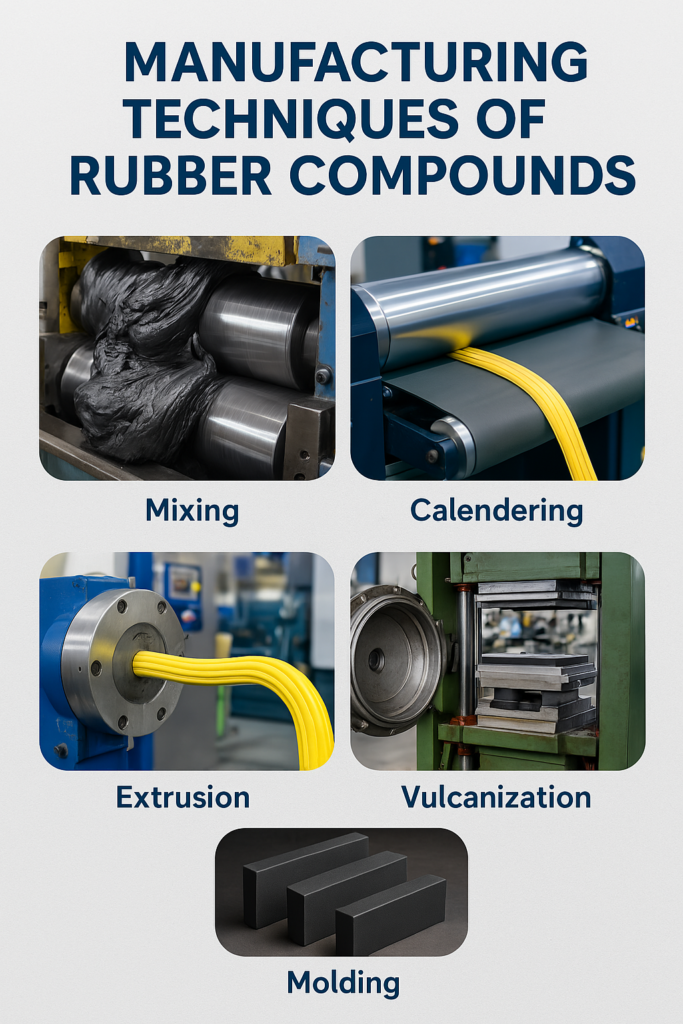
The manufacturing techniques of rubber compounds are as follows:
Mixing
Mixing is the process of blending raw rubber with various additives, including fillers, curing agents, plasticizers, and stabilizers, to achieve the desired properties. This is done using equipment such as internal mixers, like Banbury mixers, or open roll mills, which facilitate mastication and dispersion kneading.
The objective is to create a homogeneous rubber formulation with a uniform distribution of ingredients. The benefits of proper mixing include improved elasticity, tensile strength, and wear resistance. Challenges such as overheating, improper dispersion, and batch inconsistencies affect the quality of the final compound.
Calendering
Calendering is a sheet-forming process in which rubber is passed through a series of rotating rollers to produce thin sheets or coatings with controlled thickness. This method is widely used in making rubber sheets, conveyor belts, and fabric-reinforced products.
The calendering process involves roll milling, where rubber is fed between rollers under high pressure to create smooth, uniform layers. Calendering also offers excellent control over sheet dimensions and surface finish, making it ideal for precision applications.
Calendering requires strict control of temperature and pressure to prevent inconsistencies in thickness and mechanical properties.
Extrusion
Extrusion is a continuous shaping process where rubber is forced through an extrusion die to create specific profiles such as tubing, hoses, and sealing strips. The rubber compound is first softened through heat and mechanical work, then pushed through a shaped die, followed by cooling or pre-curing before final processing.
Rubber extrusion ensures high efficiency in producing complex cross-sectional shapes and provides excellent consistency in rubber products. Controlling die swelling and maintaining uniform material flow are challenging, requiring precise formulation adjustments and process monitoring.
Vulcanization
Vulcanization is the curing process that transforms raw rubber into a durable, elastic material by chemically cross-linking the polymer chains. This is achieved by applying heat and pressure in the presence of sulfur or other curing agents. The process uses different techniques, including hot pressing and continuous curing.
Vulcanization enhances the strength, elasticity, and thermal stability of rubber, making it suitable for high-performance applications such as automotive tires, industrial seals, and molded products. Vulcanization requires careful temperature control to prevent over-curing or under-curing, which compromises the material’s performance.
Molding
Molding is the process of shaping rubber into finished products by applying heat and pressure in molds. It includes various methods such as compression molding, injection molding, and transfer molding.
Compression molding involves placing raw rubber into a heated mold and then pressing it into shape, while injection molding forces molten rubber into a mold cavity for rapid production. Transfer molding allows for precise control over complex shapes.
Molding techniques provide excellent dimensional accuracy and versatility in product design. However, the process is time-consuming for large-scale production and requires high initial tooling costs.
What are the Benefits of Rubber Compounds?
The benefits of rubber compounds are improved durability, increased temperature tolerances, maximized chemical resistance, precise density control, enhanced seal performance, increased flexibility, and optimized processability. These advantages make rubber compounds ideal for various industrial applications, ensuring high performance, longevity, and adaptability to extreme conditions.
The benefits of rubber compounds are as follows:
- Improve Durability: Rubber compounds are formulated with reinforcing agents such as carbon black and silica to enhance wear resistance, tensile strength, and longevity. This makes them ideal for high-stress applications like tires and industrial seals.
- Increase Temperature Tolerances: By incorporating heat-resistant additives, rubber compounds withstand extreme temperatures without degrading. This ensures reliable performance in automotive, aerospace, and industrial applications.
- Maximize Chemical Resistances: Rubber compounds are designed to resist oils, fuels, solvents, and harsh chemicals. This makes them important for use in seals, gaskets, and hoses in the chemical and oil & gas industries.
- Meet Exact Density Specifications: The compounding process allows for precise control of rubber density. This ensures the right balance of hardness, flexibility, and buoyancy for specific applications such as marine and automotive components.
- Improve Seal Performance: Rubber compounds provide excellent compression set resistance, allowing seals and gaskets to maintain their shape and function under pressure. This prevents leaks and improves the lifespan of sealing systems.
- Increase Flexibility: Rubber’s inherent elasticity is enhanced through compounding, making it ideal for applications requiring repeated stretching, bending, or deformation, such as conveyor belts, vibration dampeners, and medical devices.
- Optimize Processability: Rubber compounds are engineered for efficient manufacturing processes. It ensures ease of mixing, molding, and curing, which helps reduce production costs and improve overall product quality.
How To Choose the Right Rubber Compound?
To choose the right rubber compound, it is important to consider its properties and key factors such as mechanical strength, resistance to environmental conditions, and cost-effectiveness. The selection process depends on the specific application requirements, ensuring that the rubber compound provides durability, flexibility, and optimal performance under different working conditions.
To choose the right rubber compound, the below-mentioned things are followed:
- Mechanical Properties: The rubber compound must have suitable tensile strength, elongation, and hardness to withstand mechanical stress. This ensures durability in applications like automotive parts, seals, and conveyor belts.
- Resistance Properties: The ability of the rubber to resist chemicals, oils, heat, and abrasion is necessary for ensuring long-term performance in industries such as oil & gas, marine, and healthcare.
- Environmental Factors: Exposure to UV rays, ozone, extreme temperatures, and moisture should be evaluated, as rubber compounds with high weatherability and thermal stability perform better in outdoor and industrial environments.
- Cost Considerations: The selection of a rubber compound should balance performance and cost-effectiveness, considering material availability, processing efficiency, and overall lifecycle costs to ensure economic feasibility.
Why is Rubber Compounding so Important Today?
Rubber compounding is so important today because it allows manufacturers to create customized rubber materials with precise properties suited for diverse industrial applications. Rubber compounds are customized for improved durability, flexibility, chemical resistance, and temperature stability by modifying the formulation with additives, fillers, curing agents, and stabilizers.
The process of rubber compounding is important in industries such as automotive, aerospace, healthcare, and oil & gas, where specialized rubber materials are required for safety and performance. Advancements in rubber compounding help develop eco-friendly and sustainable alternatives, reducing environmental impact while maintaining high-performance standards.
As industries continue to demand high-quality, durable, and cost-effective materials, rubber compounding remains important in meeting evolving technological and commercial needs.
Is There Any Difference Between Natural and Synthetic Rubber Compounding?
Yes, there is a difference between natural and synthetic rubber compounding, primarily in their base materials and performance characteristics. Natural rubber compounding uses latex from rubber trees, providing excellent elasticity, tensile strength, and abrasion resistance.
In contrast, synthetic rubber compounding is based on petroleum-derived polymers, allowing for better customization of properties such as chemical resistance, heat stability, and durability in extreme environments.
Both types of rubber are used in different industries depending on specific application needs.
The main differences between natural and synthetic rubber compounding are as follows:
|
Aspect |
Natural Rubber Compounding |
Synthetic Rubber Compounding |
|
Source |
Derived from the latex of rubber trees |
Made from petroleum-based polymers |
|
Elasticity & Strength |
Higher elasticity and tensile strength |
Customizable strength and flexibility |
|
Chemical Resistance |
Limited resistance to oils and chemicals |
Enhanced resistance to oils, fuels, and harsh chemicals |
|
Temperature Stability |
Performs well in moderate temperatures |
It is formulated for extreme heat and cold conditions |
|
Durability |
Good wear resistance but degrades over time |
More resistant to aging, ozone, and UV exposure |
|
Cost & Availability |
Natural fluctuations in price and availability |
More stable pricing and consistent supply |
|
Environmental Impact |
Biodegradable but requires sustainable sourcing |
Non-biodegradable but is engineered for recyclability |
What Are the Advancements in Rubber Processing and Compounding?
The advancements in rubber processing and compounding are automation, nanotechnology, sustainable materials, and enhanced curing techniques. Modern automation and AI-driven systems have improved precision and efficiency in mixing, extrusion, and molding processes.
Nanotechnology has enabled the development of high-performance rubber compounds with superior strength, wear resistance, and flexibility. The use of sustainable materials, such as bio-based polymers and recyclable rubber, is reducing environmental impact while maintaining performance.
Advanced curing techniques, including microwave and dynamic vulcanization, have optimized processing speed and energy efficiency, making rubber manufacturing more cost-effective and sustainable.
What Chemicals Can Improve a Rubber Compound?
Sulfur, carbon black, silica, accelerators, and antioxidants can improve a rubber compound by enhancing its durability, elasticity, and resistance to environmental factors. These chemicals optimize the mechanical properties, processing efficiency, and long-term performance of rubber materials. Manufacturers customize rubber compounds to meet specific application requirements, ensuring superior quality and functionality by carefully selecting the right additives.
The following chemicals can improve a rubber compound:
- Sulfur: Sulfur is a key vulcanizing agent that forms cross-links between polymer chains, improving the rubber’s elasticity, strength, and heat resistance. It enhances the overall durability and mechanical performance of the final product.
- Carbon Black: Carbon black acts as a reinforcing agent, significantly increasing tensile strength, abrasion resistance, and UV protection. It also helps in heat dissipation, making rubber compounds more durable in high-stress applications like tires and industrial belts.
- Silica: Silica fillers enhance wear resistance, improve grip, and lower rolling resistance, making them important in high-performance rubber applications such as fuel-efficient tires and specialized industrial seals.
- Accelerators: Accelerators speed up the vulcanization process, reducing curing time while improving the uniformity and flexibility of the rubber compound. This leads to better processing efficiency and enhanced mechanical properties.
- Antioxidants: Antioxidants prevent rubber degradation caused by oxidation, heat, and UV exposure, extending the lifespan of rubber products. They are important for maintaining performance in outdoor and high-temperature applications.
- Plasticizers: Plasticizers enhance the flexibility and softness of rubber compounds, making them more adaptable for applications requiring high elasticity, such as seals, gaskets, and medical devices.
- Flame Retardants: Flame retardants improve the fire resistance of rubber compounds, making them safer for use in electrical insulation, automotive interiors, and aerospace applications.
- Processing Aids: Processing aids improve the flow properties of rubber during manufacturing, ensuring better dispersion of fillers and additives, leading to uniformity and ease of production.
Is Rubber Compounding Safe?
Yes, rubber compounding is safe when conducted with proper controls and adherence to industry regulations. The process involves handling various chemicals, such as curing agents, fillers, and stabilizers, which require strict safety protocols to prevent exposure to harmful substances.
Modern advancements have led to the development of non-toxic, eco-friendly additives and improved workplace safety measures, reducing health and environmental risks. The rubber industry ensures the safe production and usage of rubber compounds in various applications by following standardized guidelines and using sustainable raw materials.
Is It Possible to Produce Sustainable Rubber Compounds?
Yes, it is possible to produce sustainable rubber compounds using bio-based polymers, recycled rubber, and environmentally friendly additives. Innovations such as natural rubber alternatives, biodegradable fillers, and energy-efficient processing techniques are helping to reduce the environmental impact of rubber manufacturing.
Advancements in recycling technology allow for the repurposing of used rubber products, minimizing waste, and promoting a circular economy. With a growing emphasis on sustainability, the industry is continuously evolving to create high-performance rubber compounds with reduced carbon footprints.
What Are Some Common Rubber Compound Additives?
Some common rubber-compounding additives are fillers, plasticizers, antioxidants, accelerators, and stabilizers. These additives enhance the mechanical properties, durability, processing efficiency, and overall performance of rubber compounds. Manufacturers customize rubber materials to meet specific application needs, ensuring optimal strength, flexibility, and resistance to environmental factors by carefully selecting the right combination of additives.
The following are the common rubber compounding additives:
- Fillers
- Plasticizers
- Antioxidants
- Accelerators
- Stabilizers
- Curing Agents
- Reinforcing Agents
- Processing Aids
- Flame Retardants
- Anti-Aging Agents
- Anti-Ozonants
- Pigments and Colorants
Where to Get Customized Rubber Compounds?
You can source customized rubber compounds from specialized rubber manufacturers, compounding companies, and industrial suppliers that offer customized formulations for various applications.
These providers use advanced rubber processing techniques to develop compounds with specific mechanical properties, resistance levels, and performance characteristics based on industry requirements. Many rubber manufacturers offer a wide range of customization options, including selecting base polymers, reinforcement materials, curing agents, and specialty additives.
Whether you need high-temperature-resistant rubber for automotive applications, chemical-resistant rubber for industrial use, or flexible compounds for medical devices, custom formulations ensure optimal performance. Advanced testing and quality control processes also guarantee consistency and reliability in every batch produced.
For high-quality, customized rubber compounds designed to meet your exact specifications, explore the rubber manufacturer. Their rubber formulation and cutting-edge technology expertise ensure superior performance, durability, and cost-effective solutions for various industries.

